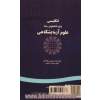کتاب English for the students of laboratory technology
تاریخ نشر: 1400
تعداد صفحه: 318
شابک: 978-964-459-468-7
قطع کتاب: وزیری
نوع جلد: شومیز
وزن: 453 گرم
رتبه فروش: #44707 (مشاهده پرفروش ترین ها)
موجودی: فقط یک جلد در انبار موجود است.
تخفیف: 1480000 ریال (57.4%)
Setting up the Microscope
If the best results are to be obtained it is of the utmost importance that the microscope is set up correctly. Two methods of adjusting the illumination, the Nelson and Köhler methods, are in universal use. Of these methods, the latter is rapidly becoming the more widely used and research microscopes equipped with built-in illumination are designed to be adjusted for Köhler illumination.
The term 'critical illumination was coined during the latter part of the last century by E.M. Nelson, the famous British critical microscopist. The method was devised in order to obtain maximum resolution and to achieve this even illumination of the whole field was sacrificed. An image of the light source is focused in the object plane, resulting in the object under examination being illuminated by a solid cone of light. Maximum resolution is therefore obtained in the centre of the field, the size of which is controlled by means of the sub-stage condenser (Figure 1-9).
Köhler illumination is named after the German scientist, August Köhler, who was famous for his photomicrography and who introduced the method in 1892.
 Testing language skills: from theory to practice ~حسین فرهادی، عبدالجواد جعفرپور
Testing language skills: from theory to practice ~حسین فرهادی، عبدالجواد جعفرپور English for the students of curriculum development ~مریم خضری نژاد، محمود مهرمحمدی، غلامرضا کیانی
English for the students of curriculum development ~مریم خضری نژاد، محمود مهرمحمدی، غلامرضا کیانی زبان تخصصی برای مهندسی مکانیک ~علی کیانی فر
زبان تخصصی برای مهندسی مکانیک ~علی کیانی فر Reading and understanding psychology ~یاسمین مندی
Reading and understanding psychology ~یاسمین مندی English for the students of educational technology (completed revised) ~Mansour Koosha
English for the students of educational technology (completed revised) ~Mansour Koosha- موارد بیشتر (507)










